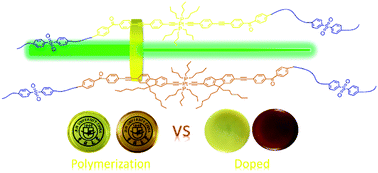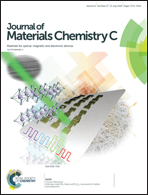Poly(arylene ether)s based on platinum(ii) acetylide complexes: synthesis and photophysical and nonlinear absorption properties†
Abstract
The design and fabrication of nonlinear absorption molecule-embedding solid-state optical power limiting materials are significant but challenging. In the present study, we first report on the synthesis and optical properties of two poly(arylene ether)s incorporating platinum acetylide in the backbones, as well as the fabrication of solid-state optical power limiting materials based on the prepared polymers. The concentrations of platinum acetylide chromophores in the polymer chains were examined to be 19 wt% and 26 wt%, which are the highest levels for non-metal polyyne polymers. Poly(arylene ether)s with platinum acetylide exhibited good mechanical strength, thermal stability, and high glass transition temperature. Investigation of their photophysical behavior revealed that at a high linear transmittance, the polymers showed longer triplet state lifetimes and larger nonlinear absorption coefficients than the corresponding platinum acetylide monomers as a result of the shielding effect. Solid-state monoliths based on platinum acetylide-incorporating poly(arylene ether)s exhibited excellent reverse saturable absorption and optical limiting performance at 532 nm, compared to the optically opaque platinum acetylide chromophore doped polymer monoliths that are formed by severe aggregation.



 Please wait while we load your content...
Please wait while we load your content...